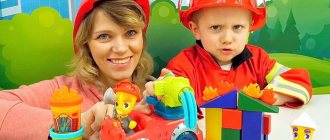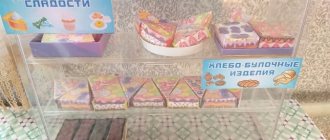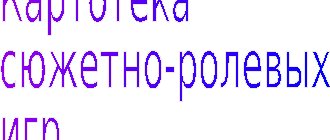Role-playing game "Bus"
Education Committee of the Berezniki City Administration
Summary of a plot-role-playing game for children of the middle group
"Bus"
Developed by: teacher M.V. Onkova
Berezniki, 2016
Thematic role-playing game “Bus”
middle group
Target:
Improve children’s ability to unite in play, assign roles, perform game actions, and act in accordance with the general game plan.
Tasks:
Educational:
- Develop the ability to change your role behavior in accordance with the different roles of partners, the ability to change the game role and designate your new role for partners in the process of unfolding the game;
- Improve children's dialogical speech;
- Teaching children to implement game plans.
Educational:
- Develop skills of social behavior in society;
- Develop interest in joint games;
- Develop communication and creative abilities.
Educators:
- Foster a culture of behavior in public transport;
- Develop communication skills, friendships and partnerships.
Expected result:
children will show interest in participating in joint role-playing games, participate in discussions of games, distribution of roles, and experience positive emotions when fulfilling the assigned role.
Activities:
gaming, communicative, educational.
Game roles:
driver, conductor, controller, passengers.
Preliminary work:
conversation on the topic “Modes of transport”, “Professions” and discussion of illustrations; children's stories about traveling on public transport; didactic game “Rules of behavior in transport”, watching the cartoon “Tram number ten was walking”.
Equipment:
pictures depicting a bus and passengers; children's chairs, steering wheel, tickets for passengers, bag for the conductor, doll, terry scarf.
Progress of the game:
Children sit on chairs, the teacher stands in front of the children.
Educator
: Guys, do you like to travel?
Children
: Yes!
Educator
: In order for us all to go on a trip, we need to choose transport. What would be the most convenient way for us to travel?
Children
: by bus.
Educator
: Okay, let's go with you by bus.
(Shows pictures of a bus and passengers).
The bus won’t go by itself, who do we need for this?
Children
: The driver, and there is also a conductor on the buses.
Educator
: That's right, guys. Now we need to build a bus, let's build it from our chairs.
(Together with the teacher, the children build a bus, distribute the roles of driver and conductor as desired).
Educator
: And then everyone else will be passengers.
(Children take their playing places).
Educator
: Guys, I'll give a radio alert. Is everyone ready? Has everyone taken their seats?
Children
: Yes!
Educator
: Be careful, the doors are closing. The bus starts to move.
(The driver imitates the movements of the steering wheel, passengers sit on chairs, the conductor hands out tickets).
Educator
: Stop, peace, carefully the doors open.
(Passengers get off the bus. Passengers at the stop enter the bus. The teacher, dressed as an elderly passenger, enters the bus. All seats are occupied).
Children
: Sit down grandma.
(give way).
Educator
: thanks guys.
(sits down)
. What great kids, I know that we need to give way to the older ones.
(They drive on. The children's voluntary actions. Dialogue between the children and the old woman. The bus arrives at the stop, the passengers change. The teacher changes clothes, takes the doll. Enters the bus.)
Educator
: Here guys, look how small my doll is.
(The children pay attention to her and give up their seat. Stop, the teacher gets out. He gets on the bus as a passenger).
Educator
: Guys, I see the controller is approaching, we need to get our tickets ready.
(In advance, the chosen role of the controller, walks along the bus and checks tickets).
Educator
: Guys, everyone’s tickets are in order, where should we go on our bus?
(Various answers from the children. They go on a trip).
Educator
: Oh, guys, a tire has burst on our bus. What do we do now?
Children
: We need to pump him up.
(Children play out the situation according to their own plans.)
Educator
: Well done, now we can move on.
Educator
: So our journey with you has ended. Did you like it?
Children
: Yes, I really liked it.
Educator
: Then next time you and I will definitely go somewhere else.
Plot-role-playing game “Travel by bus around the city of Chita” (Senior group)
Story-based role-playing game
"Travelling by bus around the city of Chita"
(Senior group). Teacher of MBDOU No. 10 - .
Objectives: To consolidate children’s knowledge about their hometown and its culture. In a playful way, give children the idea that a city is not only houses, but also the people living in it who contribute to prosperity and development
Chita. Develop children's creative imagination, imagination, and ability to maintain a play situation. Using game simulations, let children feel involved in creating the image of their hometown. Foster love and respect for landmarks and memorable places. Develop speech, thinking, enrich the vocabulary of preschoolers. To foster an ecological culture, a sense of national pride, and a sense of friendship towards people of other cultures living nearby.
Preliminary work:
1) Reading books by G. Graubin, M. Vishnyakov. 2) Meeting with the writer. Presentation of his book “Walking in Old Chita”. 3) Conversations about the city of Chita, about sights, about cultural monuments. 4) Learning poems and songs about Chita. 5) Drawing “Where is this street, where is this house.” 6) Parents’ participation in introducing children to their hometown
(Organization of city tours, by bus, making models of houses and courtyards in Chita). 7) Presentations of the Daursky Nature Reserve on various topics. Reading chapters from the “Red Book of the Trans-Baikal Territory”, looking at illustrations and photographs of endangered animal species. 9) Classes in the children's library named after. N. Ostrovsky: “The Red Book is a Book of Alarm”, “The History of the Creation of the City of Chita”, “We Live in the Trans-Baikal Territory”, “The Stone Book of Transbaikalia”, “A Friendly Family of Peoples”, etc.
7) Presentations of the Daursky Nature Reserve on various topics. Reading chapters from the “Red Book of the Trans-Baikal Territory”, looking at illustrations and photographs of endangered animal species. 9) Classes in the children's library named after. N. Ostrovsky: “The Red Book is a Book of Alarm”, “The History of the Creation of the City of Chita”, “We Live in the Trans-Baikal Territory”, “The Stone Book of Transbaikalia”, “A Friendly Family of Peoples”, etc.
Materials used:
Photographs with views of Chita, reproductions from paintings by Transbaikal artists, recordings of songs about Chita, about Transbaikalia. Photographs and illustrations of animals listed in the “Red Book...”. Mini-museum “My Chita”, poems from the book “Transbaikalia – my golden cradle”. Models of houses and courtyards made by the hands of parents, a Lego constructor, a map - a diagram of the city of Chita, a didactic game “Assemble a whole from parts” (views of the city).
Game motivation: The mayor of the city of Mikhalev invites children on a tour of his hometown.
Progress of the game: 1) Set up. Children enter the hall and greet the guests. Educator: - Guys, do you like to travel? (Children's answers.) Vs: - What kind of transport would you like to travel by? (Children answer.) Warm-up “A steam locomotive has come to us...” 2) - Guys, I got a call from the City Hall today. invites us on a city tour on a bus. But first answer me this question: what city do we live in? (Children answer.) Now take your seats on the bus. Our journey begins. (Children get on the bus, the driver takes his seat. The conductor hands out tickets). Musical warm-up “On the bus.” V — l: — I will be a tour guide. Our bus is leaving. We go to Lenin Street. This is the main street of our city. What other streets do you know? (Children's answers.) 3) The first stop is the Chita Zoo. Guide: - We arrived at the Zoo. Zoo workers will talk about the animals living here and show those animals that are listed in the RED BOOK. (Children playing the roles of Zoo workers tell and show their charges.) The “Zoo Director” asks the children riddles about animals listed in the Red Book of Transbaikalia: “TAEZHA” (Author - V. Andryuk.) 1. Does not know how to take this little taiga basket. He will carry this berry with him in his mouth. There are stripes on his back, like stripes on a sailor's suit. A good friend to everyone in the forest. Call the taiga...(chipmunk). 2. This motley taiga has very sharp teeth and claws, a delicate sense of smell, and a cat-like appearance; Looks where to catch someone. It's climbing up through the trees... Hide, everyone! In ambush...(lynx). 3) Between the rocks, where there are networks of trails, these taiga are looking for food. They have sharp hooves, so as not to fall off the cliff. They run from the enemy to the sludge (the place is quiet). They should still be given horns. These animals are .....(musk deer). 4) Only in clean water I love to frolic. The fur is beautiful, dear, I am very proud of myself. And there are membranes on my paws so I can swim. I'm a jerk, sometimes - girls are named after me. I'm a rare animal, as you can see! Did you guess who I am?…..(otter) (author’s – ) Educator: — You know the inhabitants of the zoo well. But the bus is waiting for us. Let's move on! (The children continue on their way to the music.) Second stop - “Television”. Child - announcer: - The “Festival of National Cultures” is being filmed here. Our region is rich in people of different nationalities. But our closest brothers are the Buryats. The representative of this people, Bulat, will tell you a poem: A little shepherd gallops across the field on a dashing horse. He doesn't go to school yet, and his name is Arslan. He can herd sheep, he just needs to grow up. Our Arslan shoots accurately, knocks down a branch on the fly. Our Arslan is very accurate - He is a rider and a shepherd! Educator: - Buryats are the most accurate archers. They take first places even at the Olympics. Can you boast of accuracy? Outdoor game “Hit the target.” (Darts with suction cups.) Child announcer: Our festival continues. Girls from the preparatory group will sing a song about Chita. (“Look how the sun is over Chita today.”) Vocal: -Our journey continues. Please get on the bus! (Children move on.) Warm-up for the neck muscles “Look...”: Look left, look right, Look forward - then vice versa: Look left, and then right, And then back! And so 5 times in a row!
Third stop - Art Museum. The guide invites children to an exhibition of works by Transbaikal artists. Vlada reads the poem “My Chita” (author’s). The article is accompanied by a multimedia presentation.
(They are on the bus again. The guide asks about the reservoirs located within the city. The children answer.)
The fourth stop is the bank of the Ingoda River. The guide invites children to take a deep breath of fresh river air, walk barefoot on the sand, and soak their hands in the water. Children with a teacher perform the original song “Ingoda”.
(The journey continues. The guide suggests that the children take a nap.)
Fifth stop - Urban architecture. The children are met by the Chief Architect of the city (Child). He leads the guys to a map - a diagram of the city of Chita. ARKH-R shows the children empty places on the city map, says that it is planned to build kindergartens of the future in these places, and offers to help in developing projects. Children use LEGO construction sets to build projects for the kindergarten of the future. The architect evaluates the children's work. We say goodbye to him and go to the bus.
The last stop is kindergarten. The children say goodbye to the driver and approach the teacher. Educator: - Well, guys, did you like our trip? (Children's answers) - What interesting things did we see? Who did you help? The teacher’s phone rang: “Hello!” Yes. Hello, Anatoly Dmitrievich! Yes, thanks for the tour. Yes, okay, everything was handed over to us. Goodbye! - Guys! The mayor of our city called me. He asked if the children knew their hometown. I answered him that you are great, that you know and love your Chita. Because you are such good citizens of our city, the Mayor asked me to give you the flags. Thank you. (Children say goodbye to the guests and go to the group).
Get text
An outdoor game with elements of a role-playing game for children 4-6 years old
An outdoor game for middle and high school children
An outdoor game with elements of a role-playing game “Fun Bus”
Author: Marina Vladimirovna Rukavishnikova, teacher of MBDOU No. 91 “Voice”, Bratsk, Irkutsk region. Description of material: entertainment scenario for children 4-6 years old (middle, older group). The material may be of interest to educators. The scenario can be divided into two games: an outdoor game, which can be played both in a group and on a walk with children, and a role-playing game “bus”. Goals: to develop children’s coordination of movements, dexterity, and enrich the motor system. To develop children’s ability to correctly select attributes for the game and complete assigned tasks. Strengthening children's ability to communicate with friends by playing a certain role. Creating a joyful mood. Attributes for the game: chairs, steering wheel, conductor's bag, tickets, hoop. PROGRESS OF THE GAME: Presenter (teacher): Guys, you’re feeling sad... do you want us to play? Children: yes! Presenter (teacher): Let's take a ride on the bus, not just a regular one, but a “Vesyoly” one? Children: Let's go! Presenter (teacher): But where can we get a bus? Let's build it! Children use chairs to build a bus. Presenter (teacher): So our bus is ready... Who usually drives the bus? Children: (children's answers)
driver, driver.
Presenter (educator): Who works with the driver? Who gives tickets to passengers? Children: conductor Presenter (teacher): Correct! Well done - you know everything! This means we need to choose a driver and conductor for our Fun Bus. Let's stand in a circle. (children stand in a circle) Guys, what does a driver need to drive a bus? Children: ( children's answers)
steering wheel!
Presenter (teacher): That's right - steering wheel! Here it is (shows the steering wheel). With the help of this steering wheel we will find a driver for us. I will turn away, and you pass the steering wheel to each other in a circle. As soon as I say “stop”, you stop, and whoever has the steering wheel in his hands will be the driver. Ready? Let's start! (choose a driver) Presenter (teacher) : Here is our driver. Your role is to drive the bus. At each stop, after passengers take their seats on the bus, you must say: “Careful, the doors are closing! Let's move on! " Get on the bus. (sits down)
Did you forget the words?
Driver: “Careful, the doors are closing! Let's move on! " Presenter (teacher): Now we need to choose a conductor. We will also choose, only this time we will hand over the bag to the conductor. Ready? Let's start! (Choose a conductor) Presenter (teacher): Conductor, look what’s in your bag? Of course tickets! You must give tickets to passengers and escort them to their seats on the bus. How are you going to do that? Conductor: Here's your ticket! Please sit down here! Presenter (teacher): Well done! You are an excellent conductor! And we guys will be passengers, and we will board the bus at different stations. Look, I’m putting a hoop in the center of our circle. We will walk with you in a circle, one after another, and sing a magic song. As soon as the song ends, 3 people must jump into the hoop. Whoever takes a seat at the hoop (stop)
will ride on the bus.
Shall we try? The wheels are spinning (the children pretend to be steering with their hands)
The motors are knocking
(we are spinning or knocking with our fists)
Our cheerful bus is calling for a ride for the kids!
Children jump into a hoop. We warn them not to push each other. The presenter announces a stop. Presenter (educator): Stop “Smeshilkino” Guys, if the stop is called “Smeshilkino”, what should the guys do at this stop? Children: laugh! Presenter (teacher): Correct! Laugh! (children in hoops laugh) Well done, you can get on our “Fun Bus” Conductor: Here is your ticket! Please sit down here! Driver: “Careful, the doors are closing! Let's move on! " Presenter (teacher): Let's move on! (repeat the song and movements)
Children and presenter: Wheels are spinning, Motors are knocking... Our cheerful bus is calling for a ride for the kids!
Presenter (teacher): stop "Dancevalkino" The game continues until all the children get on the bus. Stop options: “Stoyalkino on one leg”, “Prygalkino”, “Prisedalkino”, “Quickly Pomorgalkino”, etc. The last stop is “Opazdalkino” - you need to depict fast running on the spot. All the children received tickets from the conductor and are sitting on the bus. Driver: “Careful, the doors are closing! Let's move on! " All the children, already sitting on the bus, repeat the song with movements.
The wheels are spinning, the motors are knocking... Our cheerful bus brought us to kindergarten!
Presenter (teacher): stop “Kindergarten” So we arrived back to our kindergarten... Oh, look, the driver of the Fun Bus turned back into our (child’s name), and the conductor turned into our (child’s name), and the Fun Bus turned into our chairs, which need to be placed in their places.
We recommend watching:
Outdoor games for preschool children Games for younger preschoolers on the topic Animals Organization and conduct of outdoor games in various types of activities Outdoor games for children 3 years old
Similar articles:
What is a plot-based role-playing game?
Outdoor games for children aged 1, 2, 3 years
Outdoor game for children “Birds of Migratory”
Outdoor games for children 3-4 years old in kindergarten
Outdoor games for preschoolers in kindergarten




